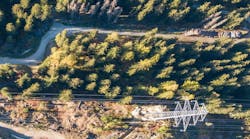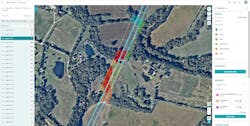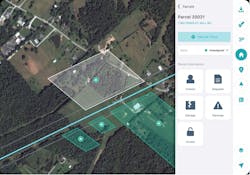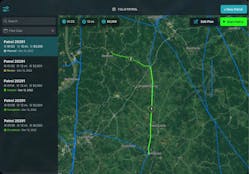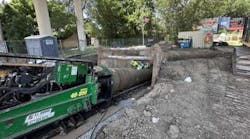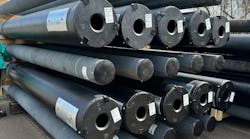Extreme weather events like floods, storms and wildfires have become both more frequent and more intense due to climate change. The wildfire season is no longer a season, as the risk of wildfires exists year-round. Utilities are reacting to ignitions across T&D power lines — from equipment failures to contact with foreign objects, such as vegetation — and must consider the latest prevention strategies.
Even with the most precise technology, managing vegetation still requires a fair amount of human intervention, which underscores another challenge utilities are facing: a transitioning workforce. Are utilities adequately equipped and staffed for holistic wildfire prevention?
With Power, Comes Responsibility
Power lines can ignite wildfires in many ways.
For example, through vegetation contact. The Dixie Fire, the second-largest wildfire in California’s history, was sparked when power lines owned by Pacific Gas and Electric Co. (PG&E) came into contact with a tree. Trees and other vegetation intruding into power lines can spark fires; a fallen tree across a line can tear it down, resulting in a downed line; a branch spanning two line conductors can ignite the branch, eventually break the line and cause a fire.
Power lines are designed with clearance between conductors, but certain circumstances can cause a conductor slap. A conductor slap ejects hot metal particles that can burn as they fall, causing a fire.
Downed lines also pose a risk. When a power line conductor breaks and falls to the ground, it can remain energized and spark nearby vegetation.
High winds can also blow trees and branches into power lines or snap wooden distribution line poles, causing live wires to fall onto nearby dry grass, sparking fires.
For these reasons, it is critical utilities take proactive measures to prepare for and prevent wildfires. Wildfire prevention requires four stages: planning, detection, monitoring and optimization.
1. Plan
Before the first flicker of a wildfire, utilities must initiate preparation initiatives that go beyond traditional measures. These strategic plans, not only reactive but anticipatory, are meticulously crafted, emphasizing the need for a 360-degree view to enhance grid resiliency.
At the heart of this preparatory phase are critical technologies such as optical and multispectral satellites, light detection and ranging (LiDAR), drone and aerial imagery, and AI-powered vegetation management. These innovations empower utilities with tools that transcend the limitations of traditional methods. The controlled monitoring of vegetation, identified as a potential threat to power lines, becomes a proactive move rather than a reactive response.
Tools such as optical and multispectral satellites provide utilities with a bird’s eye view of their vast service territories. This early detection mechanism becomes a crucial aspect of planning, allowing utilities to initiate preventive measures with precision.
AI-powered vegetation management elevates the game further. It transforms the monitoring process into a dynamic system that learns over time. By processing vast datasets, AI algorithms can predict patterns, assess risks and provide actionable insights that can help utilities to adapt their strategies based on evolving environmental conditions. Integrating algorithmic solutions can enable utilities to prioritize their cut plans based on organizational constraints, factoring in the likelihood and consequence of risks and calculating optimal maintenance cycles for different areas of the grid.
In essence, the preparatory phase is not just a routine exercise in ticking boxes; it is a commitment to foresight and an acknowledgment that in the intersection of technology and preparedness lies the key to a resilient and fortified future.
2. Detect
During a wildfire, utilities must leverage valuable data they have collected in the lead-up to the fire and in real time to effectively execute the plans they have in place. This phase is not just about preventing immediate damage to power systems but also safeguarding the broader environment.
The dynamic nature of a wildfire demands quick and adaptive strategies to the persistent workforce challenges, ranging from logistical constraints to ensuring the well-being of field crews. Effective communication becomes the bedrock of seamless coordination among stakeholders, including emergency services, communities and government agencies. Simultaneously, stringent safety measures must be enforced — extending beyond typical protocols to safeguard lives, ecosystems and critical infrastructure.
Wildfire and vegetation threat detection play a pivotal role during this time. Leveraging advanced satellite and thermal technology, utilities can receive near-real-time detection of hot spots and insight into an inventory of hazard trees in and around the right-of-way that includes height, canopy shape, genus and some species, health and growth characteristics.
Additionally, using wildfire spread models, utilities can visualize the fire's potential spread on a rolling 12-hour basis. Incorporating spatial analysis and real-time weather data, this model aids in determining the direction, speed and intensity of the fire, offering insights into its potential impact on infrastructure, ecology and communities. This comprehensive information enables both field and system operations personnel to make critical decisions on switching, protection and coordination with suppression agencies.
Timely and accurate information from these platforms transforms the complex dynamics of a wildfire into comprehensible analytics, empowering utilities to make informed decisions and take necessary actions swiftly.
3. Monitor
In the aftermath of a wildfire ignition, the focus shifts to continued monitoring and in-depth analysis. Real-time solutions lead to real-time awareness, where asset, weather, crew, equipment and environmental data are combined seamlessly, giving operators a comprehensive view to make informed decisions at the right time. This functionality is essential to understanding changing conditions and forecasting the fire's predicted path through specialized weather models.
Post-event assessment, robust communication strategies and meticulous damage evaluation are crucial elements in preventing further damage and risks. This enables utilities to plan strategically and execute restoration and cleanup operations.
4. Optimize
In this phase, the lessons gleaned from past events act as catalysts for innovation. It marks the transformation of challenges into opportunities, as utilities recognize the importance of continuous improvement. The focus on optimization extends beyond immediate responses; it is an unwavering commitment to long-term innovation and ideation.
Utilities navigating through this stage should not be content with static strategies. Instead, they should invest in dynamic and adaptive plans where the impact of wildfires is not only minimized but strategically mitigated. This commitment resonates in every aspect of their strategies — from advanced technologies to streamlined communication protocols.
The optimization phase involves a closed-loop, reinforcement learning approach, exemplified by vegetation manager tools. These tools can act as a critical component, understanding contributing factors to wildfires while consolidating stakeholder and in-house knowledge for future reference. This closed-loop system is indispensable to the prevention strategy, continuously building on field insights and data points to improve AI models.
These models predict where and when the next tree strike or ignition is likely to occur, ensuring utilities not only learn from their experiences but also integrate these insights into future prevention strategies. By optimizing their approach, utilities position themselves at the forefront of wildfire prevention, becoming experts in resilience.
A Resilient Future
The need for a holistic prevention plan becomes evident as climate change makes environmental conditions rife for wildfires. As utilities navigate through these increasing environmental threats, the path forward is clear: Collaboration and sustained investment in prevention strategies are vital.
The role of comprehensive prevention plans, such as those involving advanced technologies like AI-powered vegetation management and modernization driven by real-time data, becomes evident. By addressing each stage of prevention — from meticulous planning and real-time execution to continuous monitoring and strategic optimization — utilities can fortify their defenses against the growing threats.
Jeff Pauska is a global product director at Hitachi Energy. He has over 15 years of digital and product experience working for Hitachi in capital-intensive industries. As a key presenter chosen by the California Public Utilities Commission for its inaugural Wildfire Technology Innovation Summit and the CEATI board for multiple speaking events, Pauska brings a diverse perspective leveraging his global experiences from utilities operating in Japan, Australia, Canada, the UK and the U.S. He holds an MBA degree from Northwestern University's Kellogg school of management.
